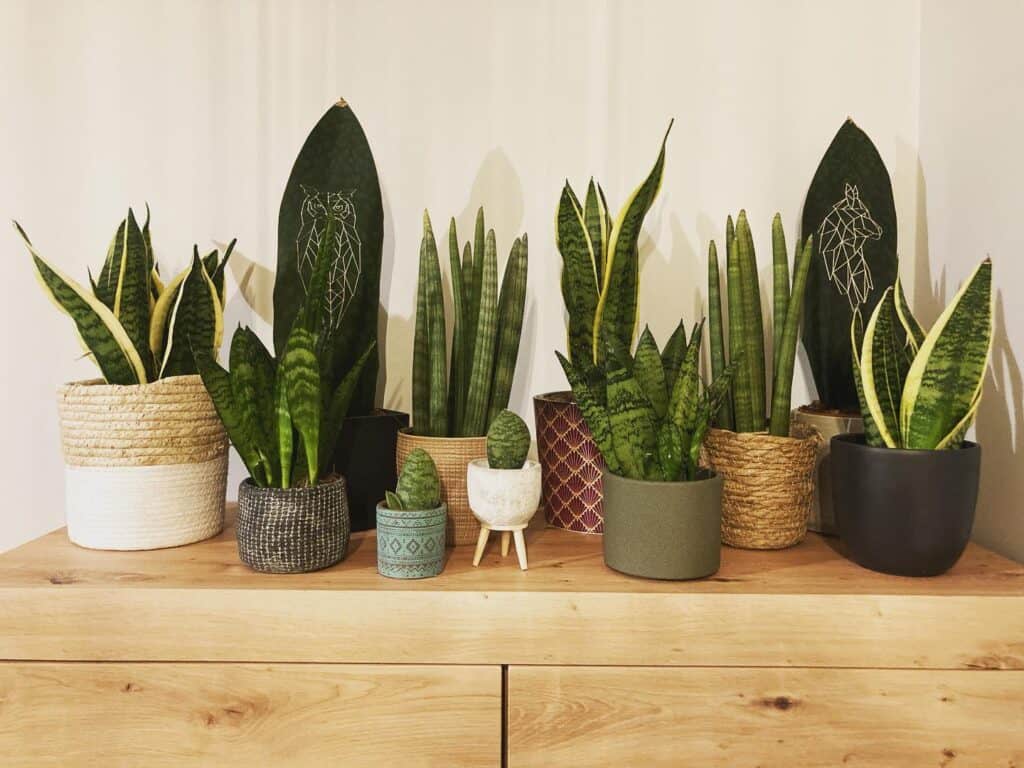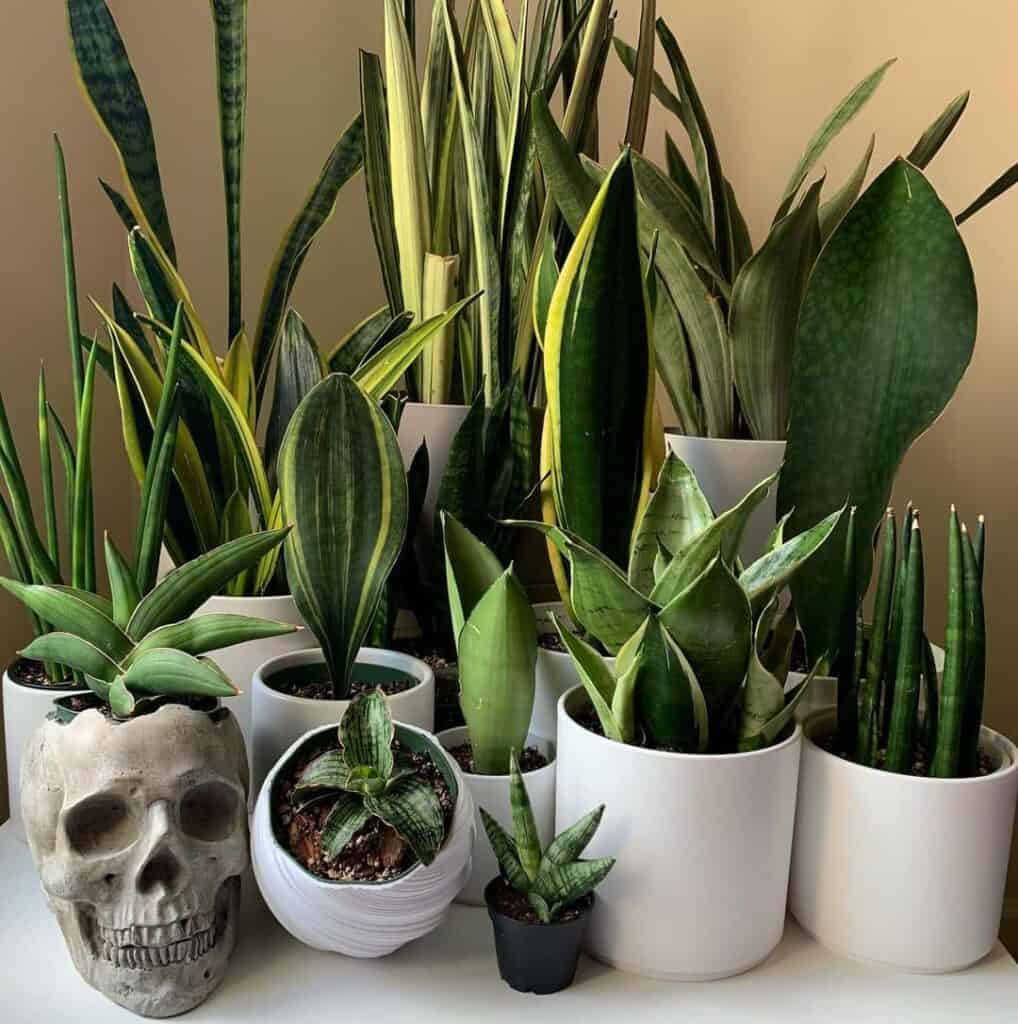How to Care for Indoor Snake Plants and Make Them Grow Faster
If you want your indoor snake plants to thrive and grow faster, you’ll need to get the basics right. Providing the right amount of light, water, and nutrients is key. But there’s more to it than that. Proper repotting techniques and staying on top of potential issues can make a big difference in the health and growth of your plants. Follow the right steps, and you’ll be rewarded with lush, vibrant snake plants that will impress anyone who sees them. Curious to learn more? Keep reading to discover the secrets to snake plant success.

Contents
Lighting Requirements for Snake Plants
Snake plants thrive in bright, indirect light. Place them near a sunny window, but avoid direct sunlight, which can scorch their leaves.
If your home doesn’t get a lot of natural light, supplement with a grow light set to 12-14 hours per day. Avoid low-light areas like hallways or bathrooms – snake plants won’t grow well in the shade.
Be mindful of seasonal changes, too; adjust your plant’s position as needed to ensure it receives enough light year-round. With the right amount of illumination, your snake plant will reward you with rapid, vigorous growth. Just don’t let it sit in direct sun, or you may see its leaves start to yellow and wilt.
Optimal Watering Techniques
Water your snake plant thoroughly, but don’t overdo it. These plants thrive on infrequent watering, as they’re prone to root rot if kept too moist. During the growing season, water when the soil’s top inch becomes dry to the touch, typically every 2-3 weeks.
In winter, cut back watering to once a month. Always use lukewarm water and avoid letting the plant sit in standing water. When watering, soak the soil until it drains from the bottom. This encourages deep root growth.
Mist the leaves occasionally to increase humidity around the plant. With the right watering routine, your snake plant will grow vigorously and remain healthy.

Fertilizing Snake Plants
In addition to proper watering, feeding your snake plant with the right fertilizer can significantly boost its growth. Use a balanced, water-soluble fertilizer made for houseplants every 2-3 months during the growing season. Dilute the fertilizer to half strength to avoid burning the plant’s roots.
Apply the fertilizer directly to the soil, avoiding the leaves. Slow-release fertilizers are also an excellent option, as they provide a steady supply of nutrients over time. Just be sure to follow the manufacturer’s instructions carefully.
Proper fertilization, combined with optimal watering, will help your snake plant thrive and grow faster, rewarding you with lush, vibrant foliage.
Repotting and Transplanting
Over time, your snake plant may become too large for its current pot, indicating it’s time to repot. Gently remove the plant and evaluate the root system. If the roots are tightly coiled or growing out of the drainage holes, it’s time to transplant.
Choose a pot one size larger and fill it with well-draining potting soil. Carefully place the plant in the new pot and water thoroughly. Avoid repotting during the winter when growth is slower. Repot your snake plant every 2-3 years to keep it thriving. Be gentle to prevent damage, and ensure the new pot has proper drainage to prevent root rot.
Troubleshooting Snake Plant Issues
Troubleshooting snake plant issues can help you address any problems that arise and keep your plant thriving. If your snake plant’s leaves are yellowing, it may be due to overwatering or insufficient light. Adjust your watering schedule and ensure your plant’s getting enough sunlight.
Drooping leaves could signal underwatering, so water your plant thoroughly. Brown leaf tips often result from too much fluoride in the water, so use filtered water instead. Pests like mealybugs can be a nuisance, so inspect your plant regularly and treat any infestations promptly.

Frequently Asked Questions
How Often Should I Clean the Leaves of My Snake Plant?
You should clean the leaves of your snake plant every 2-3 months. Use a soft cloth to gently wipe the leaves, removing any dust or debris.
This will help keep your plant healthy and promote faster growth.
Can I Propagate My Snake Plant From Its Flowers?
You can’t propagate a snake plant from its flowers. Snake plants don’t typically flower indoors, and even if they do, the flowers won’t produce viable offspring.
Instead, you’ll need to propagate your snake plant from its offshoots or leaf cuttings.
How Can I Make My Snake Plant More Aesthetically Pleasing?
To make your snake plant more aesthetically pleasing, consider trimming its leaves regularly, repotting it in a decorative container, and positioning it in an area with bright, indirect light.
You can also group it with other houseplants for a cohesive display.
What Are the Benefits of Growing a Snake Plant?
Growing a snake plant has several benefits. It purifies the air, reducing toxins and improving indoor air quality.
Plus, its striking, sculptural leaves make it an eye-catching addition to any room, boosting your home’s visual appeal.
Can I Grow a Snake Plant in a Terrarium?
You can grow a snake plant in a terrarium, but it’s not ideal. Snake plants prefer more open soil and airflow.
They may become stretched and leggy in the enclosed environment of a terrarium.
Conclusion
To keep your indoor snake plant thriving, provide bright, indirect light and water it when the soil is dry. Use a balanced fertilizer during the growing season and repot the plant every 2-3 years as needed. Monitor it closely and address any issues promptly. With the right care, you’ll enjoy your snake plant’s fast growth and lush foliage.
